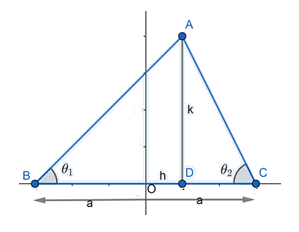Question
Question: If on a given base, a triangle be described such that the sum of the tangents of the base angles is ...
If on a given base, a triangle be described such that the sum of the tangents of the base angles is constant, then the locus of the vertex is:
A. a circle
B. a parabola
C. an ellipse
D. a hyperbola
Solution
First we need to draw a triangle on the coordinate plane. We draw a triangle by assuming BC as the base of the triangle and the length of BC=2a. Then, we draw a perpendicular to base at point D. Then, we use the property of tangent in the form of trigonometric ratio, which is given by
tanθ=basePerpendicular
Then, by adding the tangents of the base angles and solving these further we get the desired answer.
Complete step by step answer:
We have been given that a triangle be described such that the sum of the tangents of the base angles is constant.
Let us draw a diagram on the coordinate plane by assuming that the given base of the triangle is BC and the length of BC=2a

Let the coordinates of B(−a,0) and C(a,0). Also, let the coordinates of A(h,k).
We draw a perpendicular from A to base BC, which meets BC at point D.
So, we have OB=OC=a,OD=h,AD=k .
Now, we have given that the sum of the tangents of the base angles is constant.
So, we have tanθ1+tanθ2=c.....(i) where, c=constant
Now, let us consider ΔABD,
Now we know that tanθ=basePerpendicular
So, we have tanθ1=BDAD
Now, substituting values, we get
⇒tanθ1=OB+ODk⇒tanθ1=a+hk
Now, let us consider ΔADC,
Now we know that tanθ=basePerpendicular
So, we have tanθ2=DCAD
Now, substituting values, we get
⇒tanθ2=OC−ODk⇒tanθ2=a−hk
Now, substituting the values in equation (i), we get
tanθ1+tanθ2=c⇒a+hk+a−hk=c
Now, solving further we have
⇒(a+h)(a−h)k(a−h)+k(a+h)=c
Now, we know that (x+y)(x−y)=x2−y2
So, we have
a2−h2k(a−h)+k(a+h)=c⇒ak−kh+ak+kh=c(a2−h2)⇒2ak=c(a2−h2)
Therefore we can write
⇒2ak=ca2−ch2⇒ch2=ca2−2ak⇒h2=cca2−c2ak⇒h2=c−2a(k−2ca)
Now, if we replace h by x and k by y, we get
⇒x2=c−2a(y−2ca)
Now, we know that the equation of parabola is given by
⇒y−k=a(x−h)2⇒x−h=a(y−k)2
So, the equation we get is comparable to parabola.
So, the locus of the vertex is parabola.
Option B is the correct answer.
Note:
When we draw a diagram we can take vertex A,B,C anywhere. The equations of circle, hyperbola and ellipse are as follows:
Circle (x−h)2+(y−k)2=r2Ellipse a2(x−h)2+b2(y−k)2=1Hyperbola a2(x−h)2−b2(y−k)2=1
